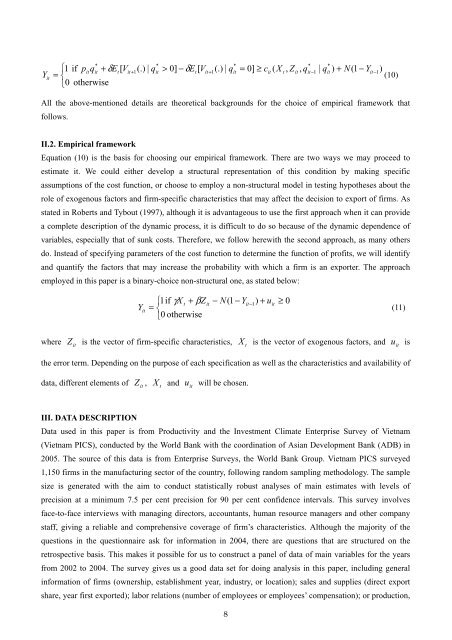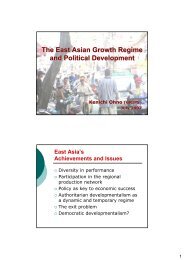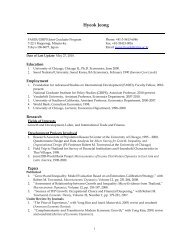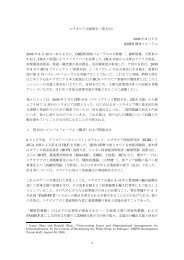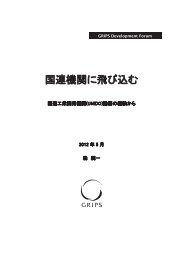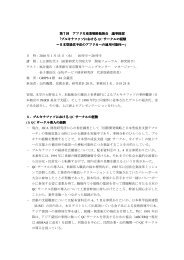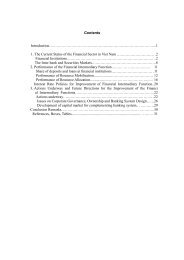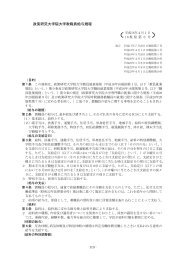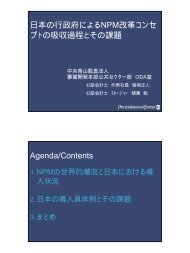Evidence from Firm-level Data in Vietnam
Evidence from Firm-level Data in Vietnam
Evidence from Firm-level Data in Vietnam
Create successful ePaper yourself
Turn your PDF publications into a flip-book with our unique Google optimized e-Paper software.
Yit*⎧ if pitqit+ δEt[V= ⎨⎩0otherwiseq> 0] − δE[ V= 0] ≥ cq ) + N(1− Y*** *1it+1(.)|itt it+1(.)|itit(t,it,it−1|itit−1qXZq)(10)All the above-mentioned details are theoretical backgrounds for the choice of empirical framework thatfollows.II.2. Empirical frameworkEquation (10) is the basis for choos<strong>in</strong>g our empirical framework. There are two ways we may proceed toestimate it. We could either develop a structural representation of this condition by mak<strong>in</strong>g specificassumptions of the cost function, or choose to employ a non-structural model <strong>in</strong> test<strong>in</strong>g hypotheses about therole of exogenous factors and firm-specific characteristics that may affect the decision to export of firms. Asstated <strong>in</strong> Roberts and Tybout (1997), although it is advantageous to use the first approach when it can providea complete description of the dynamic process, it is difficult to do so because of the dynamic dependence ofvariables, especially that of sunk costs. Therefore, we follow herewith the second approach, as many othersdo. Instead of specify<strong>in</strong>g parameters of the cost function to determ<strong>in</strong>e the function of profits, we will identifyand quantify the factors that may <strong>in</strong>crease the probability with which a firm is an exporter. The approachemployed <strong>in</strong> this paper is a b<strong>in</strong>ary-choice non-structural one, as stated below:Yit⎧ if γXt+ βZ= ⎨⎩0 otherwise− N(1− Y) + u1itit−1 it≥ 0(11)whereZitis the vector of firm-specific characteristics,X is the vector of exogenous factors, and u istitthe error term. Depend<strong>in</strong>g on the purpose of each specification as well as the characteristics and availability ofdata, different elements of Zit , Xt and uitwill be chosen.III. DATA DESCRIPTION<strong>Data</strong> used <strong>in</strong> this paper is <strong>from</strong> Productivity and the Investment Climate Enterprise Survey of <strong>Vietnam</strong>(<strong>Vietnam</strong> PICS), conducted by the World Bank with the coord<strong>in</strong>ation of Asian Development Bank (ADB) <strong>in</strong>2005. The source of this data is <strong>from</strong> Enterprise Surveys, the World Bank Group. <strong>Vietnam</strong> PICS surveyed1,150 firms <strong>in</strong> the manufactur<strong>in</strong>g sector of the country, follow<strong>in</strong>g random sampl<strong>in</strong>g methodology. The samplesize is generated with the aim to conduct statistically robust analyses of ma<strong>in</strong> estimates with <strong>level</strong>s ofprecision at a m<strong>in</strong>imum 7.5 per cent precision for 90 per cent confidence <strong>in</strong>tervals. This survey <strong>in</strong>volvesface-to-face <strong>in</strong>terviews with manag<strong>in</strong>g directors, accountants, human resource managers and other companystaff, giv<strong>in</strong>g a reliable and comprehensive coverage of firm’s characteristics. Although the majority of thequestions <strong>in</strong> the questionnaire ask for <strong>in</strong>formation <strong>in</strong> 2004, there are questions that are structured on theretrospective basis. This makes it possible for us to construct a panel of data of ma<strong>in</strong> variables for the years<strong>from</strong> 2002 to 2004. The survey gives us a good data set for do<strong>in</strong>g analysis <strong>in</strong> this paper, <strong>in</strong>clud<strong>in</strong>g general<strong>in</strong>formation of firms (ownership, establishment year, <strong>in</strong>dustry, or location); sales and supplies (direct exportshare, year first exported); labor relations (number of employees or employees’ compensation); or production,8


